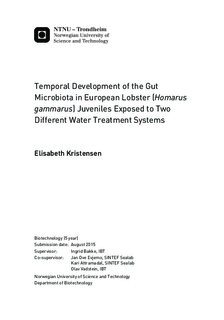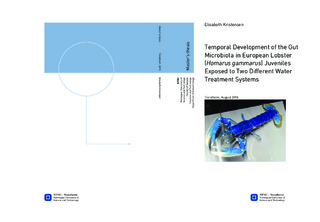| dc.description.abstract | Aquaculture today exploits only a limited number of species for production and there is a need to utilize novel species. One such species that could contribute to meeting the demands of the market is the European lobster. However, efficient and profitable rearing has thus far not been achieved due to high mortality during larval and juvenile stages. One approach in seeking a solution to this problem is to examine the microbial communities in the lobster gastrointestinal tract, as these have proved important for nutrition, the immune system and resistance to disease in many different host species, especially during early life stages. Our understanding of the microbial communities in the gut of the lobster is, however, very limited. The purpose of this study is to provide an insight into the gut microbial communities of ½-, 1- and 2-year-old lobster juveniles by studying (1) temporal development, (2) the differential effects of water treatment systems by the application of a flow-through system (FTS) and a microbially matured system (MMS) and (3) the similarity between microbial communities in feed/water and the lobster gut. To study the gut microbiota of lobster juveniles, DNA was isolated from faecal samples and PCR was applied to amplify the variable 3 region of the bacterial 16S rRNA gene. For the microbial community analysis, denaturing gradient gel electrophoresis (DGGE) was used, and community dynamics were investigated by means of statistical analysis.
The gut microbial community composition of ½-year-old lobster juveniles was significantly different from that of 1- and 2-year-old juveniles. However, no differences in the composition of the gut microbiota were found when comparing 1- and 2-year-olds lobsters. Over a time period of 3 months no temporal development was found in the microbial community dynamics in the gut of 1- and 2-year-old lobster juveniles, indicating a stable gut microbiota at these life stages. When the effect of water treatment systems on the gut microbiota was examined, significant differences in composition were found between FTS and MMS individuals 6 weeks post introduction to the water treatment systems. The bacterial community composition of both feed and water was found to be highly dissimilar to the composition of the gut microbiota in both 1- and 2-year-old lobster juveniles, indicating strong selection inside the host. In conclusion, these results appear to indicate that a stable gut microbiota, which is highly dissimilar to water/feed microbiota, has been developed by the time lobsters have reached one year of age. This suggests that host selection structures the gut microbiota. However, the results further indicate that water treatment systems have an effect on microbial community composition in the gut of juvenile lobsters. | |

